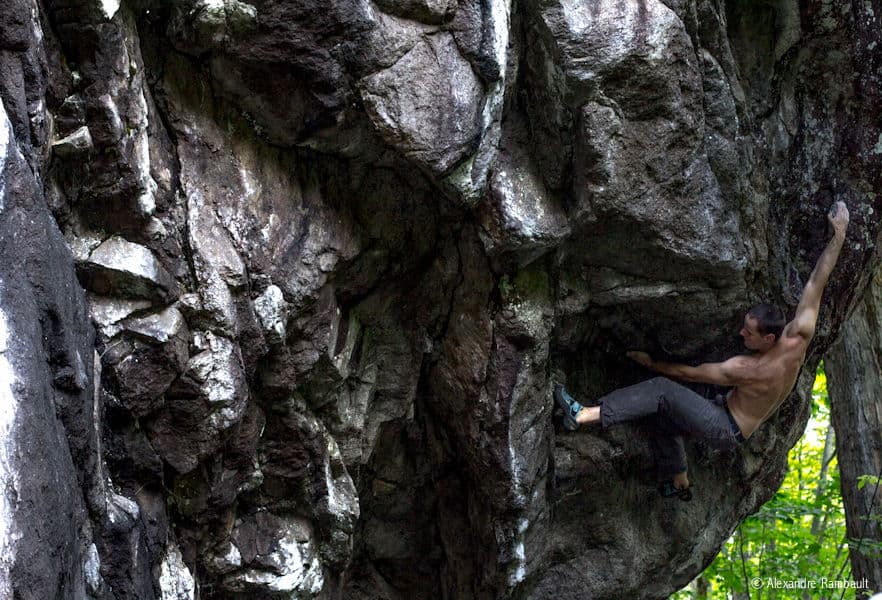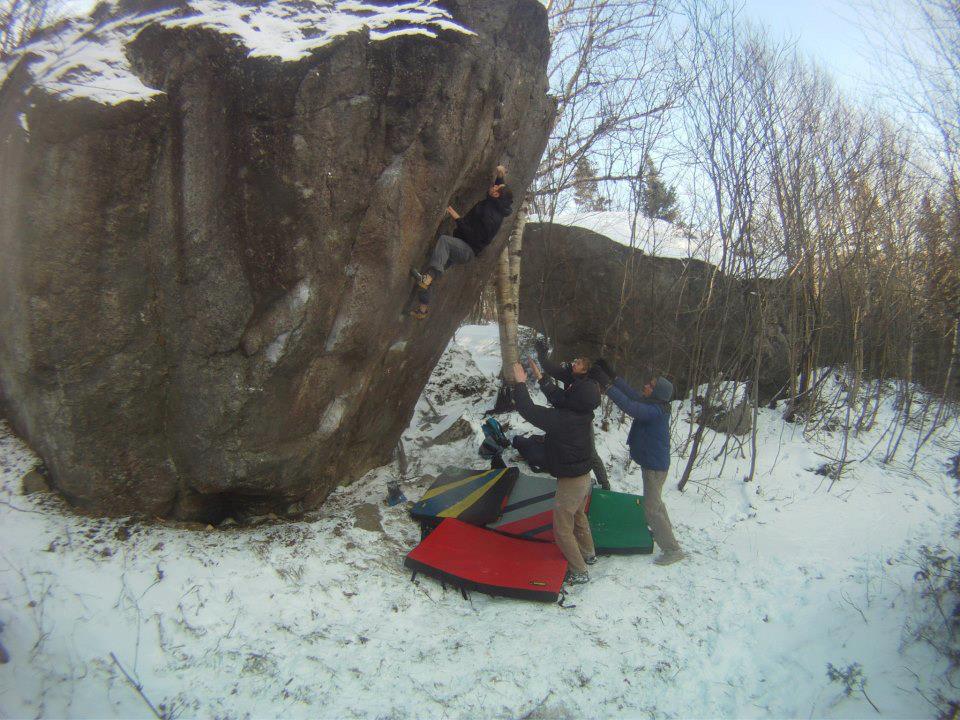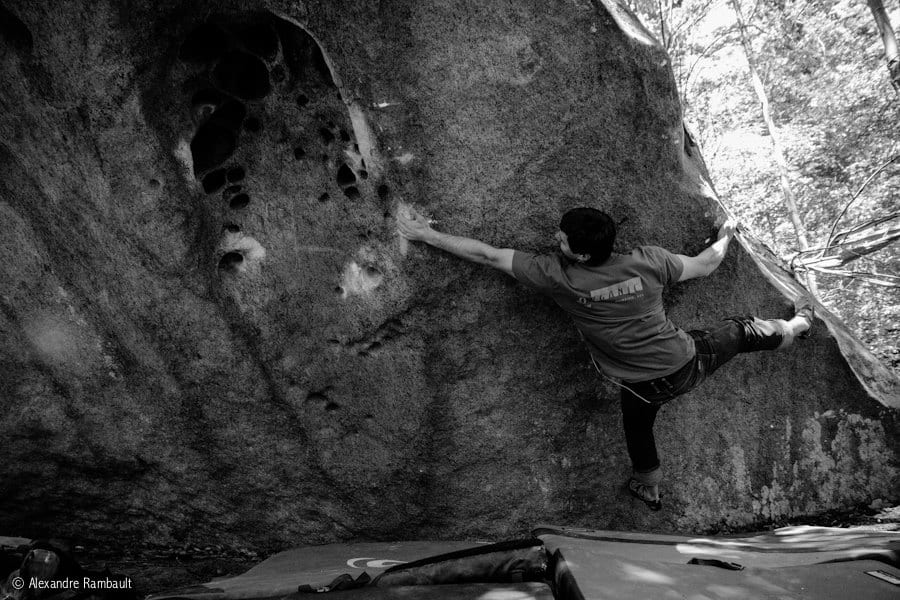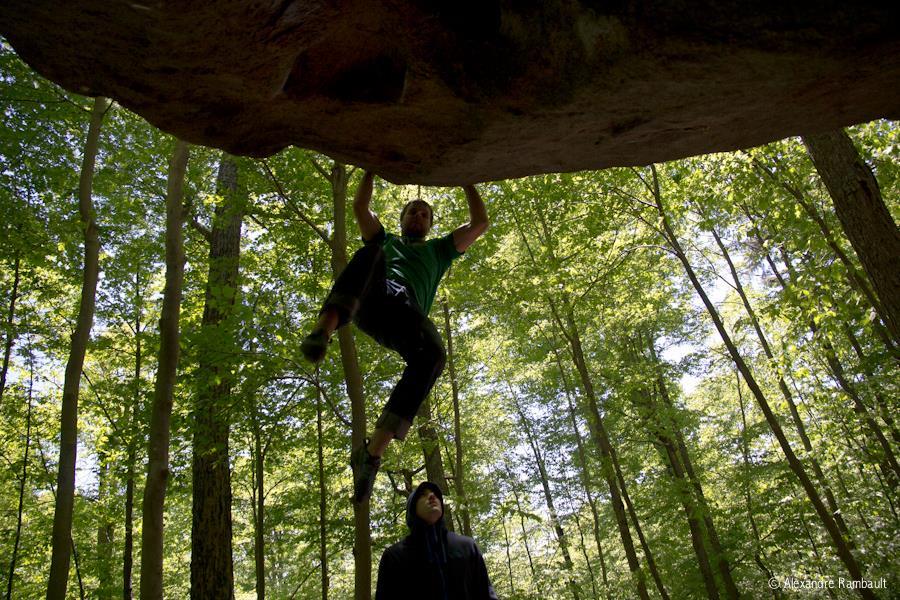If you’re one of our regular readers, you may remember an article I wrote a while back about bouldering.
If you haven’t heard of it before, then said article is an excellent place to start. For the rest of you – and especially those of you that are new to the activity or simply thinking about giving it a try – I would like to share with you an interview I did with Guillaume Raymond, a very talented kinesiologist, “pro climber,” and my climbing instructor.
We talked about everything from picking shoes to reducing pumps and anything else I could think of that would help newbie climbers. I want to issue a minor warning. Guillaume’s native language is French, and though I’ve done my best to edit, there may be a few rough edges.
Enter Guillaume…
Chad: Alright, so let’s jump right in here: Guillaume, could you tell our readers a little about yourself? What do you do, how long have you been climbing… you know, that sort of thing. Spare no details!
Guillaume: Okay, well, simple. I’m Guillaume, a 26 years old climber/personal trainer for climbers, and I try to center my life around those two passions. I started climbing in 2004; it was the first time I’d touched a climbing hold, and I went top roping. I was SO scared. I’m afraid of heights!? It is now pretty funny to look at this, knowing what kind of climbing I’m doing. After the first few years of learning, I had only one thing in mind – climbing full time.
Hah, I think fear of heights is a pretty common one. I’ve had at least a few terrified friends, especially of falling. What helped you get over your fear? Is there anything you can recommend that helped you?
Fear of falling is widespread. We’ve been walking forever, so learning to deal with your feet, not on the ground, is complex and takes patience. The first thing you have to do is start falling. Fall from a height you’re comfortable with, whether 2 feet or 10. Increase the size more every time. The second trick I could give someone is to climb while listening to music. It takes you to focus on something other than where you are on the wall. The third one might not work for everybody; it’s the crash course. Go to the top and let yourself go!
When people think of rock climbing, they usually picture people in harnesses climbing up cliff faces. How is bouldering different?
Bouldering is a condensed form of route climbing. You take 60 feet of climbing and put it in 10 to 15. This means you’ll need to go at it with full force when you leave the ground. With the nature of the climb being shorter than routes, there’s no need to use harnesses, rope, and climbing protection. We, boulderers, use crash pads, so every time you fall, there’s only one thing you know for sure: you’re going to hit the ground. But, with the climb being so short, it is one of the safest ways to climb.
Why should our readers try bouldering? I’ve heard that lifting little pink weights is an excellent way to get fit…
HAHA! That’s a good one. In another life, I was a semi-pro hockey player and thought of myself as some of the fittest… what did I know? Benching or squatting your body weight won’t help much to climb the most challenging climb. Climbing concerns your weight-to-strength ratio; beefier doesn’t mean stronger in climbing terms. A good climber isn’t the fittest athlete, but they are certainly in better shape than most people who hit the gym. Climbing is about power, endurance, core strength, flexibility, and work capacity…
So why should you try bouldering? Everything! Bouldering is everything, from a good way to fit into a social place and excellent mental training. It has everything, and it is fun, unlike regular exercise.
What does a person need to get started with bouldering? I.e., equipment, level of fitness, attitude, etc
Simple, a pair of climbing shoes if you have one; otherwise, rent some at the local gym you will try. Why can’t you wear your old running shoes? Well, the rubber used on climbing shoes is WAY stickier than any running shoes, and friction is significant in climbing, as well as regular fitness clothing and a very positive attitude. Remember that we, the human race, have been walking for the past 10,000 years, so going vertical is a little way back in our evolution…
I’m glad you mentioned shoes because that’s a big one. What should people look for in a good pair of climbing shoes? I know they need to be friendly and snug for one thing…
Your first pair of climbing shoes must be comfortable. Your first pair should allow you to walk with them. The more you climb, the more you’ll want a tighter secure fit. So the second ones you’ll get, well, that’s something else. Get them a little tighter. The more you climb, the more desensitized your feet get, and you end up like me having feet that look like hobbits ones and wearing a size 7 of climbing shoes when your street shoes are 9. But remember, climbing is about sensation, so you must feel something on the bigger toe.
Is it helpful to warm up before climbing? If so, what should people be doing exactly?
A good warm-up is quite simple and consists of 3 things. A cardiovascular activation is either jump roping, running, cycling, etc. The second component is active stretching, not static. Recent studies show that stretching statically reduces strength in strength-oriented sports. The third thing is a specific activation, climbing on big holds. Auto-massage is another good activation tool if you have access to a foam roller.
What are three common mistakes that newbies make over and over again, and what’s the best way to correct them?
- Climbing is not a contest of how many pull-ups you can do! So climb with your feet.
- Don’t sit in a corner and do everything by yourself; don’t be shy to ask questions. Unlike a conventional gym, experience climbers like to share their tips and technique with newcomers.
- Please don’t get frustrated, have fun, and be like a child who plays on the monkey bar in a park; after all, it’s climbing!
Can you tell us a bit more about climbing with our feet? Many inexperienced climbers pull themselves up the wall with their arms, but how can a person use their feet more?
It would help if you got your hips toward the wall. By doing so, you’re naturally blocking the pulling and enabling you to push with your arms. But most of all, it’s a habit! Play games like climbing with one hand, climbing blindfolded, etc.
I’ve often heard climbers described as having a frail lower body. Do you think that’s true, and if so, should people be focusing on strengthening their legs?
Climbers don’t care about leg muscles. You have a strong enough lower limb when they can take a fall. Legs mass is waste mass for climbers. So don’t even bother training them if you can walk!
What was the most important lesson you’ve learned since you started climbing?
For life in general: passion. Love what you do, and you’ll become better at it, and generally, you’ll be a more positive person for others. Passion is contagious.
Climbing wise: to become a better climber, climb, climb and climb!
Okay, so people should climb a lot to improve; it makes sense. Having said that, when I first started climbing, I would get pumped quickly and have to stop climbing. Can you explain “pump” and some suggestions to help inexperienced climbers deal with it?
The boring definition is blood stuck in your forearms because of muscle contractions. Without blood flow, a lot of organic residue stays in the muscle, creating the pump. Now the fun one: your body isn’t used to climbing, so your forearms aren’t trained for it, hence the more considerable blood flow to the forearms. Unfortunately, there’s no miracle recipe for that; climb! A little specific program might help but ask your local climbing trainer.
How are you able to climb full-time? Have you had any help over the years?
Well, climbing full-time is now possible, but it involved A LOT of sacrifices in the past years! First of all, this would not have been possible without the help of my wife. She supported me and our lifestyle for many years. Second, in the past three years, I started to work and get sponsored by some excellent companies. The first of them is Climbing Hold Review. The owner – Jeremy Dowsett – saw a lot in me and helped me get my first sponsorship. Also, there is Shakti Rock Gym in Montreal, which gave me an excellent opportunity for work and trust. They are now more friends, and the business side of the relationship is of secondary importance. L’écurie in Montreal is also sponsoring me. It is the best training facility in Montreal, and their support gave me more physical pain in my performances than anything I’ve done. Revolution Climbing is also a significant part of how I can afford to climb full time. Project Holds also supports me.
It is the whole thing that enables me to climb full-time. I still have to work 20 hours a week as a personal trainer, but I train rock climbers! I consider myself lucky to live that lifestyle, climbing, teaching myself or others, and traveling.
Is there anything else you want to tell our readers?
When you finish reading this, please go on google and find the closest bouldering gym to your home and try it.




